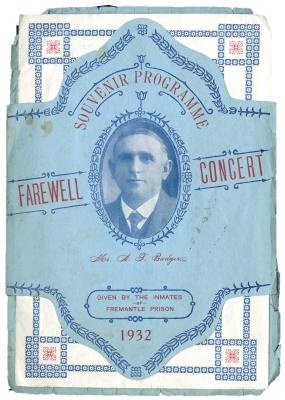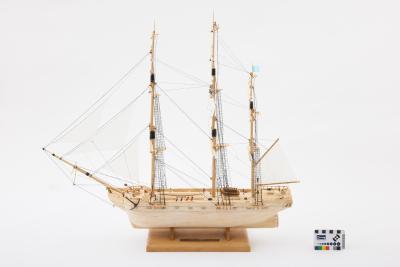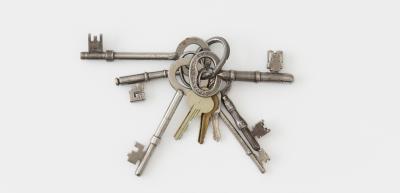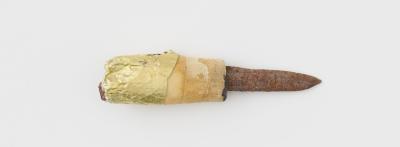REED ORGAN
1902(a) Large, wooden, Estey, upright, pedal reed organ. Large, rectangular, wooden, upright organ, with an oak case. In the centre of the organ is a single set of piano keys, in back and white, notes FF-ffff, with 14 draw-stops, four reed sets, plus 13 notes sub-bass. The cover over the keys has two long, rectangular panels set into the front, with multiple arched window shapes cut out. The patten repeats at the very top of the organ case. Attached to the front of the organ, at the top, is a small, rectangular, music stand, with the same arch wooden pattern cut out along the top. At the base of the organ are two wide, carpeted, foot pedals. The organ is stamped wit the serial number '328239'.
(b) Small, round, dark wood, organ stop. Small, round, wooden stop, with a white paper disc on the front, with black cursive printed lettering, 'Vox/Jubilante/8Ft.'
This is a Estey model H38 reed organ , which was designed for chapels. Its serial number dates its manufacture to c1900.
This organ was purchased for Fremantle Prison on 9 May 1902, after the original harmonium in the Prison’s Roman Catholic Chapel needed replacing. The Prison’s Superintendent and the Roman Catholic Chaplain corresponded for a long-time regarding funds for a new instrument, and it was finally purchased from Shotter, Row and Co. in Perth, for the sum of £35.
Part (b) was discovered detached from the organ during cleaning on 23 August 2017. The condition of the stop suggests it fell off the organ from wear and tear, rather than being snapped off.
Details
Details
(a) '328239'
The Convict Establishment placed great emphasis on religious teaching and observance of ritual. It was believed that rehabilitation or reform of a criminal was best handled by the church. Therefore, convicts were required to attend a prayer service every morning, and church twice on Sundays. Sunday church attendance remained compulsory for all inmates until 1931.
The Anglican Chapel was constructed as the centrepiece of the Prison. The large, open building looked out across the Prison gates towards the town of Fremantle. Fully completed in 1858, the Anglican Chapel is the only room in the Main Cell Block without bars on the windows. This was to create the impression of trust, to aid the prisoner’s path towards redemption. After continuous agitation from Catholic prisoners and officers for their own chapel, a Catholic Chapel was also opened at Fremantle Prison in 1862. Both Chapels had a church choir, and prisoners were rewarded for regular attendance at choir training.
Between the 1880s and the early 1900s, reed organs were mass produced in the United States and exported to other countries for use in homes, small churches and chapels. These instruments generate sound as air flows past a vibrating piece of thin metal, known as the ‘reed’, which sits within the frame. Reed organs proved very popular, as they offered a cheaper, and more easily maintained, alternative to a piano.
In 1898, the Anglican Chapel Harmonium (also in the Fremantle Prison Collection - 1995.63), needed replacing, and a reed organ was purchased. The Farrand and Votey reed organ (2016.1) is likely that replacement instrument purchased. Records show that initially a Crescent Organ was purchased from A. & E. Humphries of London, through their local agent Shotter & Co. in Perth. However, this instrument proved to be, “too weak in tone”, and was quickly replaced with the Farrand and Votey Organ.
This Estey pedal reed organ was purchased in 1902, after the harmonium in the Prison’s Roman Catholic Chapel needed replacing. Prison’s Superintendent and the Roman Catholic Chaplain corresponded for a long-time regarding funds for a new instrument, and it was finally purchased from Shotter, Row and Co. in Perth, for the sum of £35.
Two other reed organs are in the Fremantle Prison Collection: a Wertheim Hapsburg organ and the Wilcox and White. Both were found on site without attached documentation and their provenance is yet to be established. The Wertheim Hapsburg reed organ (1995.115) was imported from an undisclosed manufacturer in New York and was originally sold under the label 'Hapsburg Organ'. The Wertheim family was a famous piano and harmonium importing family located in Melbourne at the beginning of the twentieth century.
The fourth reed organ in the Fremantle Prison Collection, the Wilcox and White pedal reed organ (1995.116), has attached to its surface a circular copper medallion, with a crowned bust of Queen Victoria for her Centenary International Exhibition, shown in Melbourne in 1888. This exhibition was held to celebrate a century of European settlement in Australia. Wilcox and White were an American manufacturing company of reed organs, who established themselves in 1876 or 1877, in Meriden, Connecticut. White was the organ builder, whilst Wilcox was a silversmith. The company went bankrupt in 1921, and records regarding sales seem to have been lost or destroyed.











